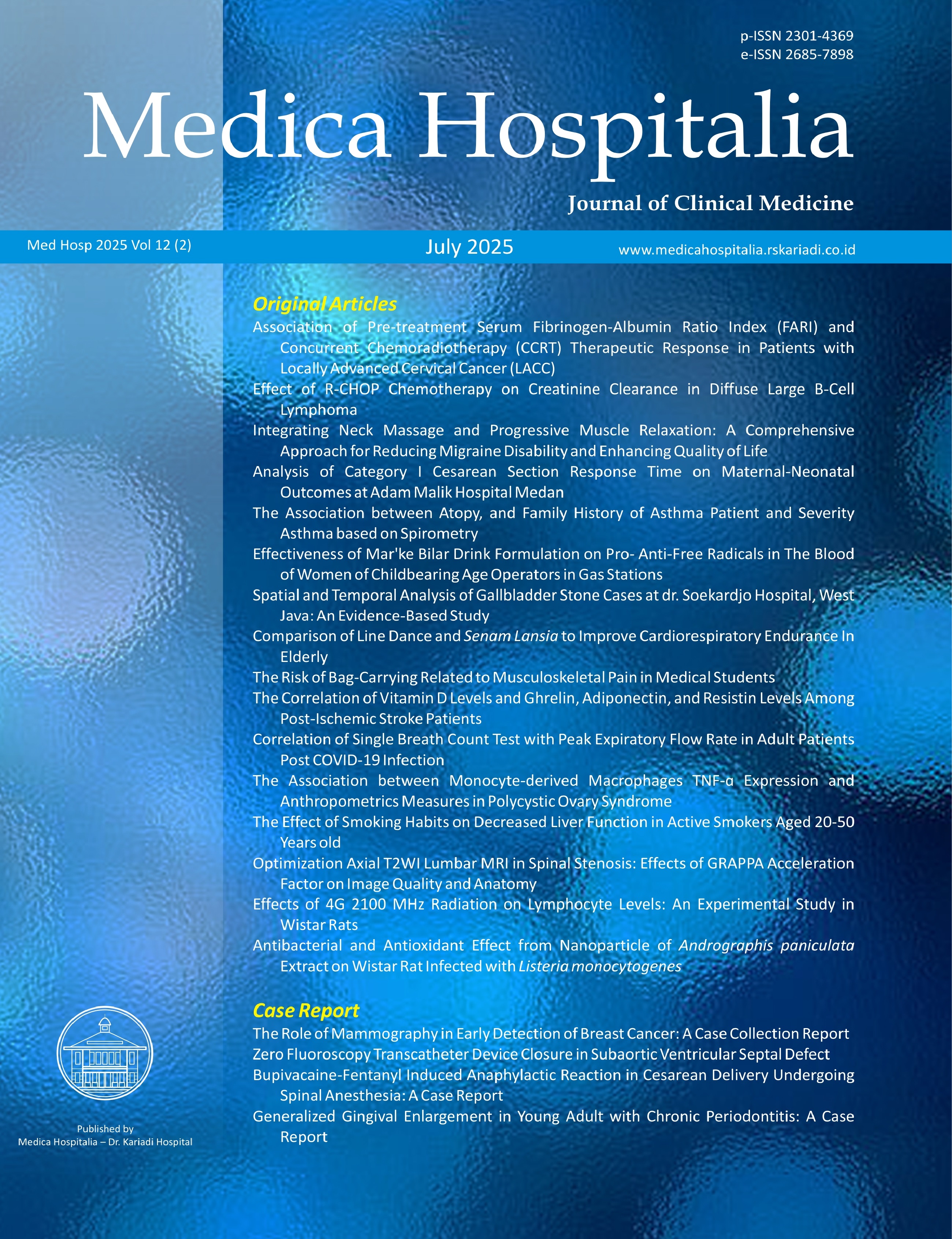Optimization Axial T2WI Lumbar MRI in Spinal Stenosis: Effects of GRAPPA Acceleration Factor on Image Quality and Anatomy
DOI:
https://doi.org/10.36408/mhjcm.v12i2.1235Keywords:
GRAPPA acceleration factor, T2WI TSE, image quality, anatomical informationAbstract
BACKGROUND: Patients with lumbar spinal stenosis (LSS) who struggle to lie down for long periods may encounter issues during lumbar MRI exams. GRAPPA, a parallel imaging method to speed up MRI scans, can reduce the Signal to Noise Ratio (SNR), affecting image quality and anatomical information.
AIMS: This study aims to find the best GRAPPA acceleration factor by assessing its effect on image quality and anatomical information.
METHOD: This study involved scans on 10 Lumbar MRI patients with LSS cases. The scans were performed using a Siemens Magnetom Aera 1.5 Tesla MRI machine with T2WI TSE axial cut. Each patient underwent 4 treatments with acceleration factors of 1 (without GRAPPA acceleration factor), 2, 3, and 4. Image quality was analysed using ROI to obtain SNR and CNR values. The radiologist assessed the anatomical information on the images. The analysis included a one-way ANOVA and the Kruskal-Wallis test was performed for image quality and anatomical information.
RESULT: The research found that the GRAPPA acceleration factor significantly affects image quality and anatomical information in axial T2WI TSE Lumbar MRI scans for patients with LSS (p-value < 0.01). A factor of 3 reduces examination time by 65.35% without significant differences (p > 0.05) in image quality and anatomical information.
CONCLUSION: The acceleration factor in axial T2WI TSE lumbar MRI significantly affects image quality and anatomical information for lumbar spinal stenosis cases. An acceleration factor of 3 is optimal for maintaining quality and anatomical information.
Downloads
References
1. Huang CC, Jaw FS, Young YH. Radiological and functional assessment in patients with lumbar spinal stenosis. BMC Musculoskelet Disord. 2022;23(1). Available from: http://dx.doi.org/10.1186/s12891-022-05053-x
2. Beasley K. Lumbar spine anatomy and pain [Internet]. Veritas Health. 2023 [cited 2023 Sep 3]. Available from: https://www.veritashealth.com
3. Aaen J, Austevoll IM, Hellum C, Storheim K, Myklebust TÅ, Banitalebi H, et al. Clinical and MRI findings in lumbar spinal stenosis: baseline data from the NORDSTEN study. Eur Spine J. 2022;31(6):1391–8. Available from: http://dx.doi.org/10.1007/s00586-021-07051-4
4. Papavero L, Marques CJ, Lohmann J, Fitting T. Patient demographics and MRI-based measurements predict redundant nerve roots in lumbar spinal stenosis: a retrospective database cohort comparison. BMC Musculoskelet Disord. 2018;19(1). Available from: http://dx.doi.org/10.1186/s12891-018-2364-4
5. Chaput C, Padon D, Rush J. The significance of increased fluid signal on magnetic resonance imaging in lumbar facets in relationship to degenerative spondylolisthesis. Spine (Phila Pa 1976). 2007;32:1883–7.
6. Fushimi Y, Otani K, Tominaga R, Nakamura M, Sekiguchi M, Konno SI. The association between clinical symptoms of lumbar spinal stenosis and MRI axial imaging findings. Fukushima Journal of Medical Science. 2021;67(3):150-60.
7. Schizas C, Theumann N, Burn A. Qualitative grading of severity of lumbar spinal stenosis based on the morphology of the dural sac on magnetic resonance images. Spine (Phila Pa 1976). 2010;35:1919–24.
8. van den Ende KIM, Keijsers R, van den Bekerom MPJ, Eygendaal D. Imaging and classification of osteochondritis dissecans of the capitellum: X-ray, magnetic resonance imaging or computed tomography? Shoulder Elbow. 2019;11(2):129–36. Available from: http://dx.doi.org/10.1177/1758573218756866
9. Sayah A, Jay AK, Toaff JS, Makariou EV, Berkowitz F. Effectiveness of a rapid lumbar spine MRI protocol using 3D T2-weighted space imaging versus a standard protocol for evaluation of degenerative changes of the lumbar spine. AJR Am J Roentgenol. 2016;207(3):614–20. Available from: http://dx.doi.org/10.2214/AJR.15.15764
10. Zaitsev M, Maclaren J, Herbst M. Motion artifacts in MRI: a complex problem with many partial solutions. J Magn Reson Imaging. 2015;42(4):887–901.
11. Deshmane A, Gulani V, Griswold MA, Seiberlich N. Parallel MR imaging. J Magn Reson Imaging. 2012;36(1):55–72. Available from: http://dx.doi.org/10.1002/jmri.23639
12. Knoll F, Hammernik K, Zhang C, Moeller S, Pock T, Sodickson DK, et al. Deep learning methods for parallel magnetic resonance image reconstruction. arXiv. 2019. Available from: http://arxiv.org/abs/1904.01112
13. Fruehwald-Pallamar J, Szomolanyi P, Fakhrai N, Lunzer A, Weber M, Thurnher MM, et al. Parallel imaging of the cervical spine at 3T: optimized trade-off between speed and image quality. AJNR Am J Neuroradiol. 2012;33(10):1867–74. Available from: http://dx.doi.org/10.3174/ajnr.A3101
14. Maulidya I, Murniati E. Perbedaan penerapan acceleration factor terhadap karakteristik citra diagnostik T2WI FSE pada MRI lumbal kasus herniated nucleus pulposus (HNP). JImeD. 2018;4(2).
15. Saifudin, Sukmaningtyas H, Indrati R, Santjaka A. Optimization of R-factor at GRAPPA parallel acquisition technique on T2 axial brain MRI. In: Proceedings of the ICASH-A31 Conference; 2020.
16. Nölte I, Gerigk L, Brockmann MA, Kemmling A, Groden C. MRI of degenerative lumbar spine disease: comparison of non-accelerated and parallel imaging. Neuroradiology. 2008;50(5):403–9.
17. McKenzie CA, Lim D, Ransil BJ, Morrin M, Pedrosa I, Yeh EN, et al. Shortening MR image acquisition time for volumetric interpolated breath-hold examination with a recently developed parallel imaging reconstruction technique: clinical feasibility. Radiology. 2004;230(2):589–94. Available from: http://dx.doi.org/10.1148/radiol.2302021230
18. Seiberlich N, Ehses P, Duerk J, Gilkeson R, Griswold M. Improved radial GRAPPA calibration for real-time free-breathing cardiac imaging. Magn Reson Med. 2011;65(2):492–505. Available from: http://dx.doi.org/10.1002/mrm.22618
19. Genevay S, Atlas SJ. Lumbar spinal stenosis. Best Pract Res Clin Rheumatol. 2010;24(2):253–65.
Additional Files
Published
How to Cite
Issue
Section
Citation Check
License
Copyright (c) 2025 Diah Nisaa Harumsari, Dwi Rochmayanti (Author)

This work is licensed under a Creative Commons Attribution-ShareAlike 4.0 International License.
Copyrights Notice
Copyrights:
Researchers publishing manuscrips at Medica Hospitalis: Journal of Clinical Medicine agree with regulations as follow:
Copyrights of each article belong to researchers, and it is likewise the patent rights
Researchers admit that Medica Hospitalia: Journal of Clinical Medicine has the right of first publication
Researchers may submit manuscripts separately, manage non exclusive distribution of published manuscripts into other versions (such as: being sent to researchers’ institutional repository, publication in the books, etc), admitting that manuscripts have been firstly published at Medica Hospitalia: Journal of Clinical Medicine
License:
Medica Hospitalia: Journal of Clinical Medicine is disseminated based on provisions of Creative Common Attribution-Share Alike 4.0 Internasional It allows individuals to duplicate and disseminate manuscripts in any formats, to alter, compose and make derivatives of manuscripts for any purpose. You are not allowed to use manuscripts for commercial purposes. You should properly acknowledge, reference links, and state that alterations have been made. You can do so in proper ways, but it does not hint that the licensors support you or your usage.
























